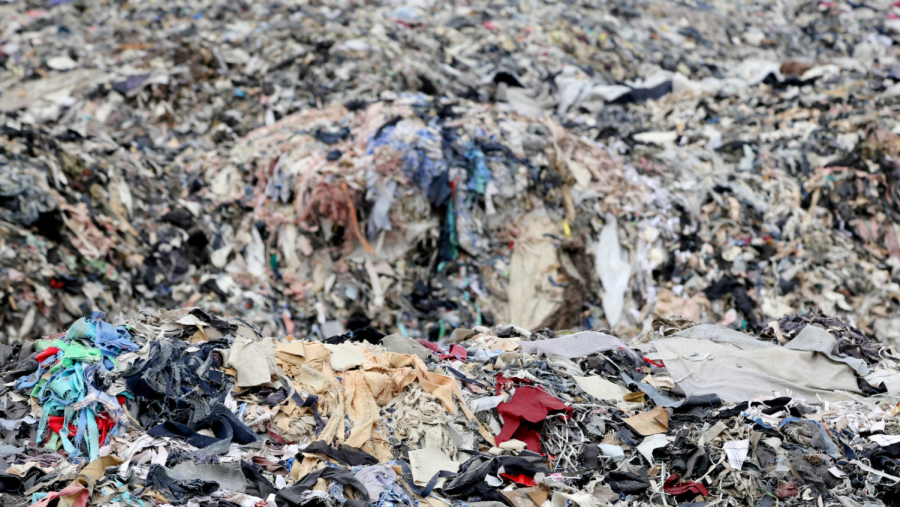The elephant in the room: Fashion in minimalism part 3
Harmful consequences of mass production with the biggest culprit, fast fashion
May 1, 2023
After targeting bad habits in part two, we are now investigating consumerism, especially fast fashion. There used to be two seasons in fashion, spring/summer and fall/winter. Today, there are 52 micro-seasons, one each week! The fast fashion industry makes trendy-cheap outfits rapidly and targets our psychology to make us feel out of trend every week. However, they are designed to fall apart!
Further investigation into fast fashion takes us out of the frying pan into the fire. According to a New York Times article, the presence of lead and hazardous chemicals have been found in them. The industry runs on fossil fuels- polyester, nylon and spandex, which are all made from petroleum. Making one cotton T-shirt, for example, requires three thousand liters of water! Fast fashion produces about 10 percent of annual global carbon emissions, which is more than all maritime shipping and international flights combined. It dries up water sources and pollutes rivers; still 85 percent of all textiles go to waste each year. Washing clothes releases 500,000 tons of microfibers into the ocean yearly which is equivalent to 50 billion plastic bottles.
Even in post-consumption, fast fashion is harmful. An average American throw away 81 pounds of clothes yearly.
Unfortunately, laborers in developing countries pay for these cheap outfits with minimum wage and hazardous workplaces. Beads and sequins in our clothing are made by child laborers of the world. In 2013, Rana Plaza, a factory in Bangladesh, collapsed; killing 1,132 people and injuring 2,500. Although workers had raised concerns about the building prior to the incident, nothing was done! These workers made products for multiple brands including Walmart and Zara. The incident caught media attention worldwide, but events like this are not rare.
Adopting minimalism comes with the responsibility to address this paradox of fast fashion. It is possible to style ourselves without damaging the planet, exploiting child labor and deteriorating our mental health.
Do I want it or do I need it?: Instead of buying instantly, ask questions like if it is a need or a want. If it is not a necessity, try putting it off for a week.
Style, not fashion: Developing a personal style instead of buying what is trendy builds a sense of personality that is unique and beyond trend.
Buying better: Combat fast fashion by purchasing clothes that last long which reduces over-consumption.
Buying secondhand: Buying secondhand means buying an item that has gone through a cycle of production where energy has already been invested. Thrifting gives that item a second life. Instead of investing in new products that would have needed new energy, possible exploitation, and pollution, thrifting saves money and the environment.
No spending day: Dedicating a day of preference as no spending day helps one to plan ahead knowing on this particular day, they won’t spend money which filters out impulsive purchases.
Make a list: Making a list prior to shopping helps one focus on what is necessary thus avoiding unnecessary shopping.
Capsule Wardrobe: A capsule wardrobe contains a few items of clothing such as tops, bottoms, shoes, and accessories that can be mix-matched to make multiple styles. Neutral color clothing is a start, but experimenting to develop individuality is possible. The idea is to keep it minimal by developing a timeless wardrobe and avoiding trend-trap.
Sewing, mending, and small repairs: We are busy wearing many hats but learning easy repairs and mending can save an attire from the landfill.
Swap parties: Hosting swap parties with friends and families where each member brings clothes from that has not been worn in a while and swapping them with each other is a fun solution.
Charity begins at home: Donating to a local orphanage, foster home or relatives who can benefit from the items is better than donating to re-sell stores. According to the United States Environmental Protection Agency (EPA), 84% of donated clothes end up in landfills.
Getting creative: Old clothes can be turned into duvet covers, trivets, notebook covers, washcloths, potholders, quilts – The possibilities are endless.
Rent a dress: On a formal occasion, instead of buying an expensive outfit that gets worn only once or twice, take advantage of many services available to rent an outfit and return it afterwards. Borrowing from friends and providing when they need an outfit is environment and wallet friendly.
Support Local: Local small businesses tend to be more environmentally conscious, purchasing local keeps the finance locally which benefits the community.
Amazon one day shipping: By having all Amazon orders coming in a specific day can reduce packaging waste. Asking Amazon to ship in cardboard instead of plastic reduces plastic waste.
Addressing Greenwashing: We see a global movement of consumer consciousness where companies are held accountable for their environmental footprints. As a result, many companies now claim their products as green, but in most cases, they are not, thus we get greenwashed. Addressing this is important.
Fast fashion is not the only culprit as many mass production goods are developed, share the same conditions and have the same environmental impacts.
The impact of fast fashion and consumerism is a hard pill to swallow. Minimalism alone cannot defeat it; we need responsible lawmakers and companies. However, together we can minimize the damage and raise awareness, it all starts with consuming less.









